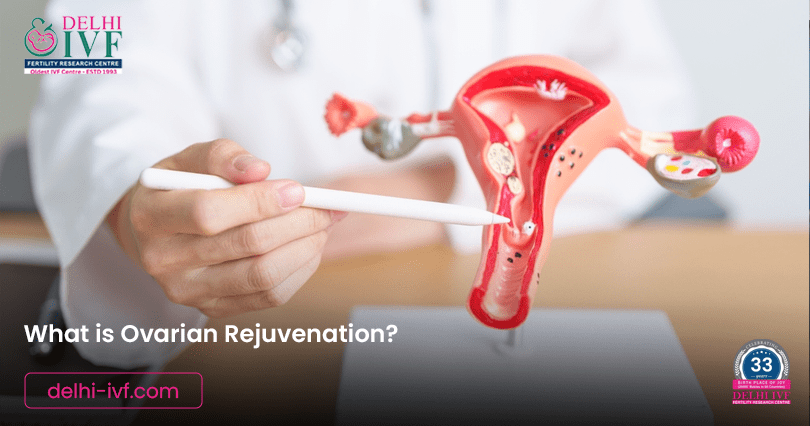
What is Ovarian Rejuvenation?
Ovarian rejuvenation is an advanced fertility treatment aimed at improving ovarian function in women with low ovarian reserve or poor egg quality. It involves techniques such as Platelet-Rich Plasma (PRP) therapy and stem cell therapy to stimulate the ovaries and promote the growth of healthier eggs.
This procedure can be beneficial for women with premature ovarian failure, poor ovarian response in IVF, or age-related fertility decline. By enhancing ovarian function, ovarian rejuvenation may improve the chances of natural conception or increase the success rates of assisted reproductive technologies like IVF.
PRP Treatment for Ovarian Insufficiency
Ovarian insufficiency, also known as premature ovarian failure (POF) or diminished ovarian reserve (DOR), is a condition where the ovaries stop functioning normally before the age of 40. Women with this condition may experience irregular periods, reduced fertility, and early menopause symptoms. Traditional treatment options, such as hormone replacement therapy (HRT) and in-vitro fertilization (IVF), may not always be successful. However, recent advancements in regenerative medicine, such as Platelet-Rich Plasma (PRP) therapy, offer new hope by stimulating ovarian function naturally.
What is PRP Therapy for Ovarian Insufficiency?
PRP therapy is a regenerative treatment that involves extracting a small amount of the patient’s blood, processing it to isolate the platelet-rich plasma, and then injecting it into the ovaries. Platelets contain growth factors and bioactive proteins that promote tissue healing and regeneration. When injected into the ovaries, PRP may help rejuvenate dormant ovarian follicles, stimulate egg production, and improve hormone levels.
PRP therapy has been widely used in orthopedics, dermatology, and aesthetic medicine for wound healing and tissue regeneration, and now its application in fertility treatment is gaining attention for its potential to restore ovarian function.
Who Can Benefit from PRP Treatment?
PRP ovarian rejuvenation is suitable for women facing the following fertility challenges:
- Low AMH Levels: Women with low Anti-Müllerian Hormone (AMH) levels, indicating a diminished ovarian reserve, may benefit from PRP treatment as it may stimulate the remaining follicles.
- Premature Ovarian Failure (POF): Women diagnosed with early menopause or ovarian insufficiency before 40 may see improvements in hormone levels and menstrual cycle regularity.
- Poor Ovarian Response in IVF: Women who have poor response to ovarian stimulation during IVF cycles may use PRP to enhance follicular growth and egg production.
- Aging and Fertility Decline: PRP may help women over 35 who experience age-related fertility decline by boosting ovarian activity and hormone production.
- Women with Unexplained Infertility: Those who have tried multiple fertility treatments without success may find PRP therapy beneficial.
Can PRP Alone Restore Ovarian Function?
Platelet-Rich Plasma (PRP) therapy has emerged as a promising technique for ovarian rejuvenation, but can PRP alone fully restore ovarian function? While PRP injections into the ovaries have shown potential in stimulating dormant follicles and improving hormonal balance, the extent of ovarian restoration varies from patient to patient.
How PRP Works in Ovarian Rejuvenation?
PRP contains growth factors and bioactive proteins that promote tissue repair, cell regeneration, and increased blood supply to the ovaries. This process may lead to:
- Activation of dormant ovarian follicles, encouraging natural egg production.
- Improved hormone secretion, particularly estrogen and progesterone, which regulate the menstrual cycle.
- Reduction in FSH levels and an increase in AMH, which are indicators of better ovarian reserve.
- Potential return of menstrual cycles in some women with ovarian insufficiency.
Can PRP Alone Be Enough?
Although PRP shows great potential, it is not a guaranteed standalone treatment for restoring full ovarian function. The success of PRP depends on:
Age and ovarian reserve – Women with some remaining follicles may respond better.
Extent of ovarian damage – Severe ovarian failure or prolonged menopause may limit the effectiveness of PRP alone.
Overall reproductive health – Other underlying conditions like autoimmune diseases or genetic factors may affect results.
PRP Works Best When Combined with Other Therapies
Most fertility specialists combine PRP with other treatments to enhance its effects:
Hormonal Therapy – To regulate menstrual cycles and support ovarian function.
IVF Treatment – PRP is often used to improve ovarian response during assisted reproductive technologies.
Lifestyle Modifications – Proper nutrition, supplements (like DHEA and CoQ10), and stress management may enhance PRP’s effects.
PRP alone may partially restore ovarian function in some women, but its best results are often seen when combined with other fertility treatments. If you are considering PRP for ovarian insufficiency, a personalized fertility evaluation at Delhi IVF can help determine the best approach for you.
Success and Effectiveness of PRP for Ovarian Insufficiency
While research on PRP ovarian rejuvenation is still evolving, early studies and clinical experiences suggest promising results:
- Some women regain menstrual cycles after PRP treatment.
- Improved AMH levels and FSH (Follicle-Stimulating Hormone) reduction have been observed in some cases.
- PRP may increase the number of retrievable eggs in IVF cycles, leading to better embryo quality.
- Some patients report natural pregnancy following PRP treatment.
However, success rates vary, and PRP is not a guaranteed solution for all women with ovarian insufficiency. It is often combined with IVF or hormone therapy to enhance fertility outcomes.
Potential Risks and Considerations
PRP treatment is generally safe since it uses the patient’s own blood, minimizing the risk of allergic reactions or infections. However, as with any medical procedure, there are some risks and limitations, including:
- No Guaranteed Results – Not all women respond to PRP therapy, and its effectiveness depends on individual ovarian function.
- Mild Discomfort – Some women experience mild pelvic discomfort or cramping after PRP injection.
- Need for Multiple Treatments – Some patients may require more than one PRP session to see significant improvements.
- Still in Experimental Stages – PRP for ovarian rejuvenation is an emerging technique, and more large-scale studies are needed to confirm its long-term effectiveness.
PRP Preparation & Infusion Procedure
Platelet-Rich Plasma (PRP) therapy is a cutting-edge technique in ovarian rejuvenation, designed to enhance ovarian function in women experiencing diminished ovarian reserve (DOR) or premature ovarian insufficiency (POI). The procedure involves extracting and concentrating the patient’s own platelets, which are then infused into the ovaries to promote regeneration.
Step 1: PRP Preparation
The preparation of PRP involves a precise process to extract a high concentration of platelets from the patient’s own blood.
1. Blood Collection
A small amount of blood (usually 20-30 ml) is drawn from the patient’s arm, similar to a routine blood test.
2. Centrifugation Process
The collected blood is placed in a centrifuge machine, which spins at high speed to separate its components. The centrifugation process separates:
Red Blood Cells (RBCs) – These are discarded.
Platelet-Poor Plasma (PPP) – This is removed as it has a lower concentration of platelets.
Platelet-Rich Plasma (PRP) – This is the final product, containing a high concentration of growth factors.
3. PRP Activation (Optional Step)
In some cases, PRP is activated with calcium chloride or thrombin to stimulate the release of growth factors before injection.
Step 2: PRP Infusion Procedure (Ovarian Injection)
Once PRP is prepared, it is carefully injected into the ovaries using a minimally invasive technique.
1. Patient Preparation
The patient is asked to fast for 4-6 hours before the procedure if sedation is required.
A mild sedative or local anesthesia is used for patient comfort.
2. Transvaginal Ultrasound-Guided Injection
A thin needle is inserted through the vaginal wall into the ovaries under ultrasound guidance.
The prepared PRP is injected directly into the ovarian tissue to stimulate the growth of dormant follicles.
3. Post-Procedure Care
The procedure is outpatient-based, requiring minimal recovery time.
Patients may resume normal activities within 24 hours.
Mild discomfort or spotting is common but resolves quickly.
How Long Does It Take to See Results?
The effects of PRP may take 2-3 months to show, as ovarian tissue gradually responds to the growth factors.
Some women experience improved hormone levels, restored menstrual cycles, and increased AMH levels after PRP therapy.
Platelet-Rich Plasma (PRP) therapy is an innovative and promising approach to ovarian rejuvenation, offering hope to women experiencing diminished ovarian reserve (DOR) or premature ovarian insufficiency (POI). By harnessing the body’s natural healing mechanisms, PRP stimulates ovarian tissue regeneration, improves hormonal balance, and may even help restore menstrual cycles and egg production in some women. While PRP alone may not be a guaranteed solution for all cases of ovarian insufficiency, it has shown encouraging results, especially when combined with hormonal therapy, IVF, and lifestyle modifications. The minimally invasive nature of the procedure, coupled with its potential to enhance ovarian function, makes it a safe and viable option for women seeking to improve their fertility.
For those considering PRP for fertility enhancement, consulting with an experienced fertility specialist is essential to determine the best treatment plan tailored to individual needs. At Delhi IVF, we offer advanced PRP therapy as part of our comprehensive fertility solutions, helping women take a step closer to achieving their dream of parenthood.
Benefits:
Word wide this therapy has been quite successful and helped women with premature ovarian failure, and menopausal women. Normally, these patients have to opt for egg donation, which has the limitation that the baby is not the biological child of the mother. With this procedure new wave of egg production starts, normal menstrual cycles are established and the couple can have their own biological child. Several children have been born following this procedure.
The Procedure:
The procedure is quite simple and is done in two steps:
- 10-20 ml of blood is withdrawn by vein puncture and it is processed for separation of PRP by standard procedure of double centrifugation. The platelet count should be 4-5 times the normal count.
- The second step is the injection of the PRP into ovaries in a procedure similar to Egg Pick up during IVF under local anesthesia. The whole procedure may take 2-3 hours.

 Your Journey to Parenthood Begins with us!
Your Journey to Parenthood Begins with us!